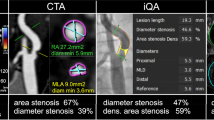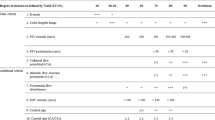Abstract
Doppler ultrasound scanning is the first line investigation for quantifying the internal carotid artery stenosis. Nevertheless, the lack of internationally accepted ultrasound criteria for describing the degree of stenosis has contributed to the different and confusing measurements ranges. The use of two different angiographic methods, the North American Symptomatic Carotid Endoarterectomy Study and the European Carotid Surgery Trial was probably the major initial source of confusion in deriving valid and reliable duplex ultrasound criteria worldwide. The consensus proposed in 2003 by the Society of Radiologists in Ultrasound has been a great attempt to create a conformity document, establishing grey scale and Doppler criteria in considering the different degrees of stenosis. According to this attempt, in 2010, the multi-parametric Deutsche Gesellschaft für Ultraschall in der Medizin ultrasound criteria have been proposed with a precise differentiation between main and additional criteria and depicted a different peak systolic velocity (PSV) threshold. In 2012, these criteria have been implemented, focusing on the multi-parametric approach, re-defining the PSV values and clearly introducing the concept of PSV average. Despite these attempts, a wide range of practice patterns still exists, with consistent disparities in patients’ care. This paper collects these previous experiences and summarizes their strengths and weaknesses, to give a contribution in the carotid artery stenosis grading standardization using ultrasonic methods. Carotid ultrasound as the only diagnostic tool for the selection of patients for carotid surgery or stenting will be possible only with internationally accepted criteria.
Abstract
L’eco-color Doppler dei tronchi sovra-aortici rappresenta la metodica non invasiva d’eccellenza per quantificare le stenosi carotidee. Tuttavia, la mancanza di criteri ultrasonografici di quantificazione del grado di stenosi universalmente accettati genera dati confondenti, spesso non equiparabili, con conseguente disparità di diagnosi, trattamento e costi. L’origine del dibattito ha avuto verosimilmente inizio a seguito della pubblicazione dei due maggiori trials angiografici, l’americano (NASCET) e l’europeo che definivano la quantificazione percentuale della stenosi dell’ arteria carotide interna in maniera oggettivamente differente. Il documento di consenso del 2003 della Society of Radiologists in Ultrasound è stato il primo tentativo di standardizzazione dei criteri, prendendo posizione sui valori soglia di velocità del picco sistolico nella quantificazione della stenosi e considerando come riferimento il metodo NASCET. Nel 2010, la Società Tedesca di Ultrasonologia (Deutsche Gesellschaft für Ultraschall in der Medizin, DEGUM), ha proposto un approccio di quantificazione multi-parametrico con percentuali di graduazione più definite e con differenti valori soglia di velocità rispetto alla proposta precedente prendendo in considerazione valori di velocità di picco sistolico (PSV) di 200 cm/s rispetto a PSV di 125 cm/s per stenosi NASCET del 50 %. Un’ ulteriore nuova proposta classificativa, comparsa sulla rivista Stroke nel 2012, non pare a tutt’oggi aver risolto del tutto il problema. La presenza di fatto di 2 valori soglia di PSV nettamente diversi, ha amplificato drammaticamente la disparità nella quantificazione della percentuale di stenosi. Permangono quindi evidenti discrepanze nella refertazione e nella comparabilità dei dati tra i diversi centri. Gli Autori hanno dunque tentato una rivisitazione critica delle classificazioni in uso e proposto un ulteriore contributo, nell’attesa di linee guida universalmente accettate che consentano una maggiore uniformità diagnostica.
Similar content being viewed by others
References
Taylor DC, Strandness DE Jr (1987) Carotid artery duplex scanning. J Clin Ultrasound 15(9):635–644
North American Symptomatic Carotid Endoarterectomy Trial Collaborators (1991) Beneficial effect of carotid endoarterectomy in symptomatic patients with high-grade carotid stenosis. N Engl J Med 325(7):445–453
European Carotid Surgery Trailists’ Collaborative Group (1991) MRC European carotid surgery trial: interim results for symptomatic patients with severe (70–99 %) or with mild (0–29 %) carotid stenosis. Lancet 337:1235–1243
ECST Collaborative Group (1998) Randomised trial of endoarterectomy for recently symptomatic carotid stenosis: final results of the MRC European carotid surgery trial (ECST). Lancet 351:1379–1387
Executive Committee for the Asymptomatic Carotid Atherosclerosis Study (1995) Endarterectomy for asymptomatic carotid artery stenosis. JAMA 273:1421–1428
Rothwell PM, Gibson RJ, Slattery J, Sellar RJ et al (1994) Equivalence of measurements of carotid stenosis. A comparison of three methods on 1001 angiograms. European Carotid Surgery Trialists’ Collaborative Group. Stroke 25:2435–2439
Grant EG, Benson CB, Moneta GL, Alexandrov AV et al (2003) Carotid artery stenosis: gray-scale and Doppler US diagnosis. Society of Radiologists in ultrasound consensus conference. Radiology 229(2):340–346
Widder B, von Reutern GM, Neuerburg-Heusler D (1986) Moprphologische und Dopplersonographische Kriterien zur Bestimmung von Stenosierungs-graden der A. carotis interna. Ultraschall in Med 7:70–75
Arning C, Widder B, von Reutern GM, Steigler H, Gortler M (2010) Ultraschallkriterien zur Graduierung von Stenosen der A. carotis interna—Revision der DEGUM-Kriterien und Transfer in NASCET-Stenosierungsgrade. Ultraschall Med 31:251–257
Von Reutern GM, Goertler MW, Bornstein NM, Del Sette M et al (2012) Grading carotid stenosis using ultrasonic methods. Stroke 43:916–921
Arous EJ, Baril DT, Robinson WP, Aiello FA et al (2014) Institutional differences in carotid artery duplex diagnostic criteria result in significant variability in classification of carotid artery stenosis and likely lead to disparities in care. Circ Cardiovasc Qual Outcomes 7:423–429
Beach KW, Bergelin RO, Leotta DF, Primozich JF et al (2010) Standardized ultrasound evaluation of carotid stenosis for clinical trials: University of Washington ultrasound reading centre. Cardiovasc Ultrasound 8:1–39
Oates CP, Naylor AR, Hartshorne T, Charles SM et al (2009) Joint recommendations for reporting carotid ultrasound investigations in the United Kingdom. Eur J Endovasc Surg 37:251–261
Klingelhofer J (2014) Ultrasonography of carotid arteries. Int J Clin Neurosci Mental Health 1(Suppl. 1):S04
Jonas DE, Feltner C, Amick H, Sheridan S et al (2014) Screening for asymptomatic carotid artery stenosis: a systematic review and meta-analysis for the U.S. Preventive Services Task Force. Ann Intern Med 161:336–346
Gray-Weale AC, Graham JC, Burnett JR, Byrne K et al (1988) Carotid artery atheroma: comparison of preoperative B-mode ultrasound appearance with carotid endarterectomy specimen pathology. J Cardiovasc Surg 29:676e81
Geroulakos G, Ramaswami G, Nicolaides A, James K et al (1993) Characterization of symptomatic and asymptomatic carotid plaques using high resolution real-time ultrasonography. Br J Surg 80:1274e7
Nedelmann M, Stolz E, Gerriets T, Baumgartner RW et al (2009) Consensus recommendations for trans-cranial colour-coded duplex sonography for the assessment of intracranial arteries in clinical trials on acute stroke. Stroke 40:3238–3244
Ni J, Yao M, Gao S, Cui LY (2011) Stroke risk and prognostic factors of asymptomatic middle cerebral artery atherosclerotic lesions. J Neurol Sci 301:63–65
Thomas GN, Lin JW, Lam WW, Tomlinson B, Yeung V et al (2004) Increasing severity of cardiovascular risk factors with increasing middle cerebral artery stenotic involvement in type 2 diabetic Chinese patients with asymptomatic cerebrovascular disease. Diabetes Care 27:1121–1126
Shen Y, Wang J, Wu J et al (2014) Elevated plasma total cholesterol level is associated with the risk of asymptomatic intracranial arterial stenosis. PLoS One 9(7):1–7
Farhoudi M, Mehrvar K, Aslanabadi N et al (2011) Doppler study of cerebral arteries in hypercholesterolemia. Vasc Health Risk Manag 7:203–207
Leng X, Chen X, Chook P et al (2013) Correlation of large artery intracranial occlusive disease with carotid intima-media thickness and presence of carotid plaque. Stroke 44:68–72
Gupta A, Marshall RS (2015) Moving Beyond Luminal Stenosis: imaging Strategies for Stroke Prevention in Asymptomatic Carotid Stenosis. Cerebrovasc Dis 39:253–261
Author information
Authors and Affiliations
Corresponding author
Ethics declarations
Conflict of interest
Authors declare that they have no conflict of interest.
Informed consent
All procedures that have permitted Authors to write this review were in accordance with the ethical standards of the responsible committee on human experimentation (institutional and national) and with the Helsinki Declaration of 1975, as revised in 2000. All patients involved provided written informed consent to enrolment in the study and to the inclusion in this article of information that could potentially lead to their identification.
Human studies
The studies that have conducted Authors to write this review article were conducted in accordance with all institutional and national guidelines for the human studies.
Rights and permissions
About this article
Cite this article
Mozzini, C., Roscia, G., Casadei, A. et al. Searching the perfect ultrasonic classification in assessing carotid artery stenosis: comparison and remarks upon the existing ultrasound criteria. J Ultrasound 19, 83–90 (2016). https://doi.org/10.1007/s40477-016-0193-6
Received:
Accepted:
Published:
Issue Date:
DOI: https://doi.org/10.1007/s40477-016-0193-6




